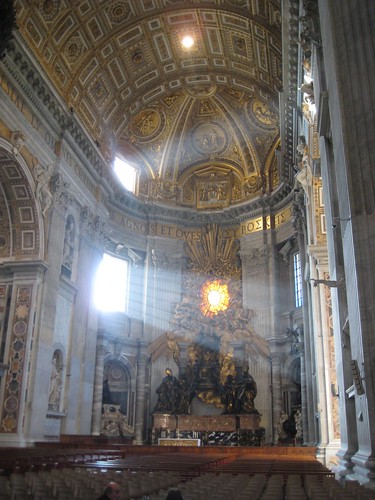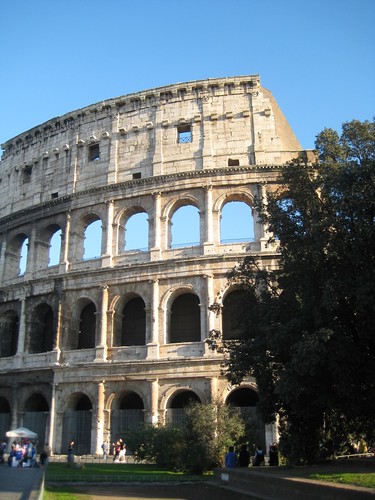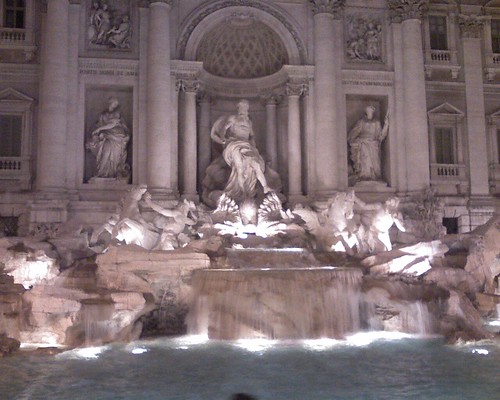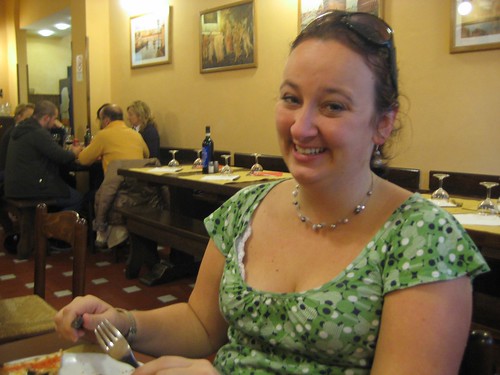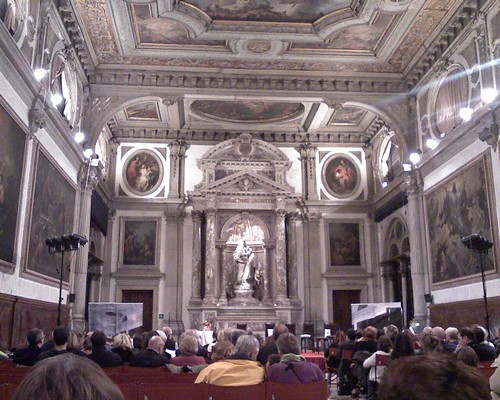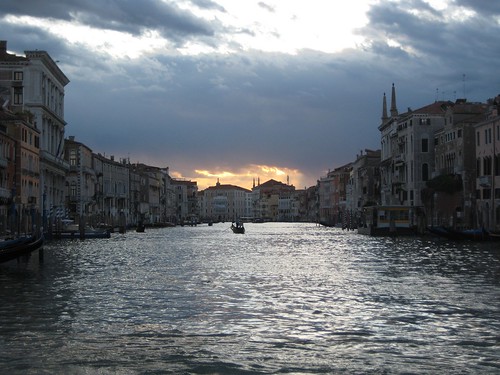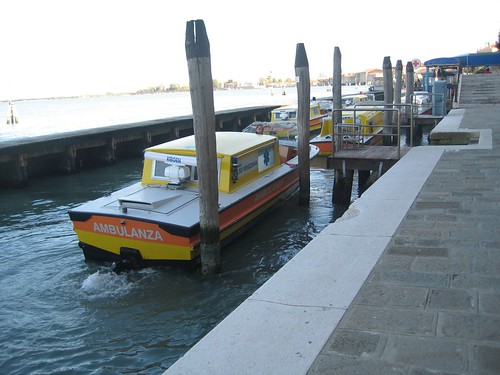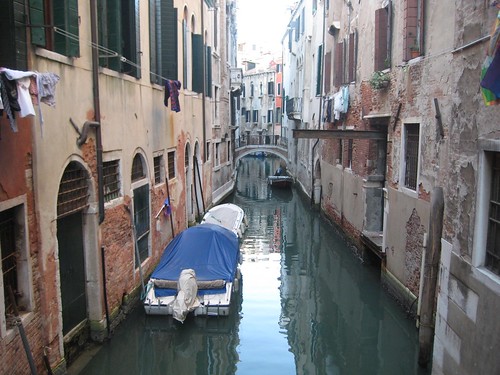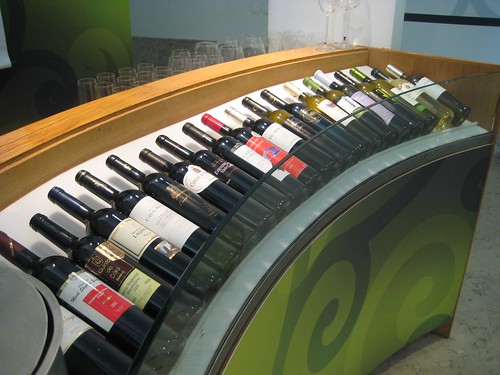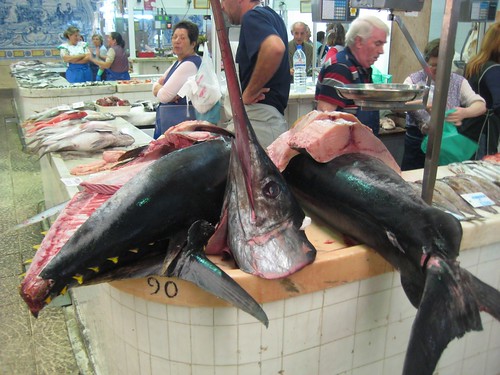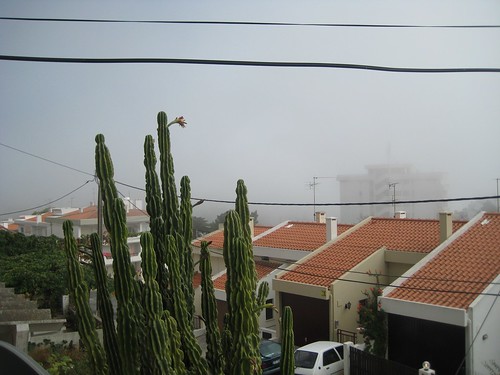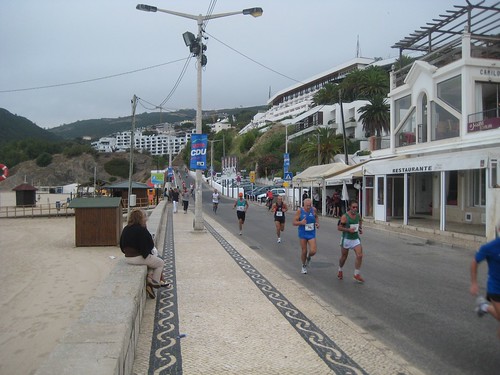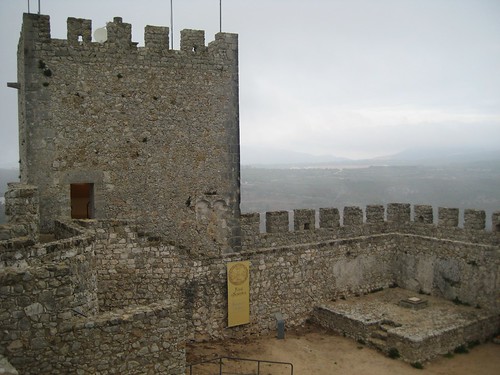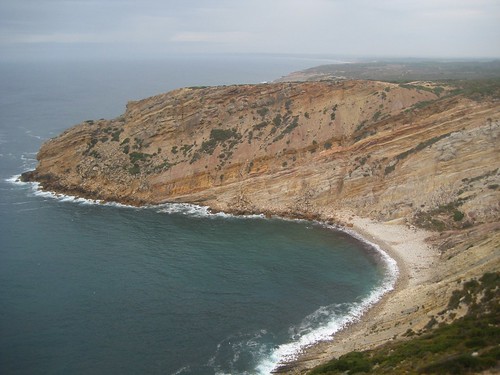Pick of Pics - The Vatican
Saturday, October 31, 2009
Posted by
Pam
at
7:00 AM
|
3 Commented
![]()
Labels: Italy, Pick of Pics
Roma
Friday, October 30, 2009
Here’s the thing about Rome: it’s been here for a really long time. Romulus settled down around 753 BC, and the Roman Republic was founded in 509 BC. And it’s not like the ancient Romans were particularly concerned about preserving their own history. Like us in modern society, they tore things down and re-built over old things and used the stones from one temple to build a new temple and so on. People have been building and tearing down and rebuilding and abandoning and reclaiming and thoroughly inhabiting the place for about 2700 years. This means that just about everywhere you turn in Rome is a mix of modern and ancient, which can be incongruous and startling and fantastic. What can I say? Rome is a city of contrasts.
For instance, the Colosseum looks like the ancient Romans built it in the middle of a roundabout. And the Area Sacrea di Largo Argentina is, as the LP says, “more of a traffic hub than an historic monument.” Discovered in 1926, it’s sunk about 20’ lower than the current street level and covers a city block. The site contains the remains of four Roman temples and a paved square and is apparently the spot where Julius Caesar was murdered in 44 BC - “Et tu Brute” and the Ides of March and all that. It also includes an impressive collection of feral cats, and convenient bus and tram connections to the rest of the city. There’s stuff like that all over. I walked a lot, and I kept stumbling on chunks of marble columns tucked away in vacant lots.
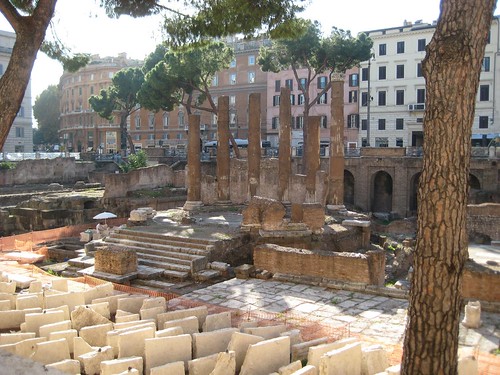 See what I mean? Ruins, buses, buildings...
See what I mean? Ruins, buses, buildings...
It's a a bit like that at the Forum. My visit to there was… confusing. It’s a huge site – it must be acres and acres of ruins, incongruously surrounded by a bustling, modern city. I got the audioguide but (as I Tweeted) it was less-than-impressive*. The commentary was very good, but it was virtually impossible to tell which particular heap of ruined what-not the friendly voice was talking about (and let’s remember that I’m not some wet-behind-the-ears audioguide neophyte - I’ve practically got an advanced degree in audioguidery at this point). Every other audioguide I’ve used to this point has worked the same way: you walk up to whatever site you’re interested in, punch in the number that’s prominently displayed on nearby signage, and listen to what the nice voice has to say. At the Forum you do this:
- Consult tiny 6” x 6” map that encompasses the entire site and attempt to orient yourself.
- Locate a number on the map and position yourself in approximately the same area.
- Punch in the number and listen attentively, trying desperately to determine if the heap of red brick on the left is the Basilica Fulvia-Aemilia, or perhaps the Temple of Castor and Pollux. Or maybe the Castor and Pollux thing is those 3 broken columns on the left. And wait a minute, did he say “Arch of Septimus Severus” or “Temple of Saturn”?
- Repeat 30 times, until you’re ready to insert your audioguide device into any available orifice of the guy who designed the map, or, most especially, whatever Hell-bent committee decided that they wouldn’t bother to put up a few discreet signs to give the tens of thousands of tourists who visit the site a fighting chance of knowing what they’re looking at. As I said in my Tweet – whoever designed that system should suffer death by a thousand paper cuts and then be forced to use his own guide to find his way to the afterlife. (“Ok, if that’s the River Styx then the boatman should be just over here… oh, no wait a minute. I must have this map upside down…”)
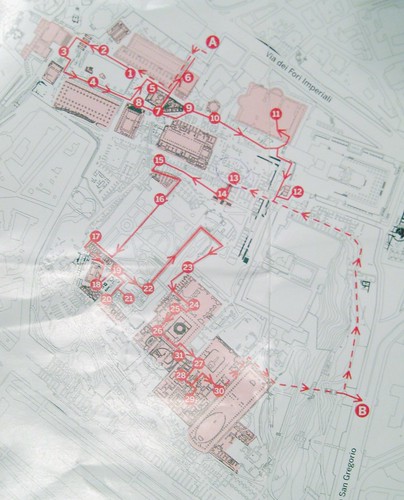 Here’s the map that came with the audioguide.
Here’s the map that came with the audioguide.
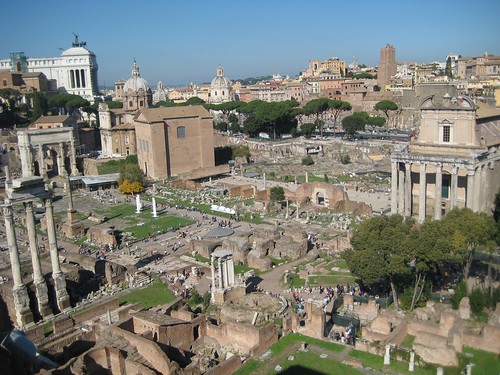 And here’s a good overview of what the site looks like. You can see why I was a bit confused.
And here’s a good overview of what the site looks like. You can see why I was a bit confused.
So the Forum was frustrating. The Colosseum, on the other hand, was quite excellent. I took a guided tour there, and that was a much better choice. It’s much more contained, so it’s not as confusing. And come on, who wouldn’t be impressed with a sight like this?
The Colosseum was great, as was my guide who was full of useful tidbits of information, like the fact that the floor contained sixty trap doors with counter-weighted elevators operated on pulleys by slaves. This meant that 60 gladiators could appear through the floor all at once. Very impressive.
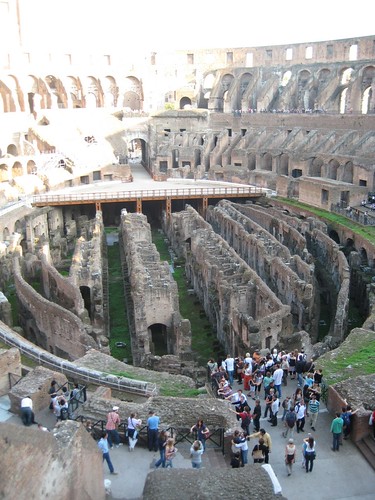 The remains of the understructure of the arena floor.
The remains of the understructure of the arena floor.
Also, there were originally no barriers between the wild animals fighting in the arena and the prominent citizens in the best seats close by. Apparently one or two senators became tiger chow before they realized they should put up nets. Hee hee.
I saw lots of other “biggie” sights too. For instance, the Trevi Fountain. And here's something weird: it turns out that I’d apparently never seen any image of the Trevi Fountain in my life before I encountered the real thing on Sunday afternoon. Honestly, when I came upon it after wandering through the maze of streets all I could think was, “Really? This is it? This is the Trevi Fountain? Well, I’ll be.” It wasn’t that it’s not lovely; in fact I lied it very much. It’s just that it was completely unexpected. Not at all the many-tiered circular wedding cake-like affair I had in my head. And on that afternoon it was positively heaving with people.
 Heaving, I said. (Sometimes I wonder how many other people's pictures I've appeared in by this point...)
Heaving, I said. (Sometimes I wonder how many other people's pictures I've appeared in by this point...)
It turns out that the best time to see the Trevi is at 12:30 am, on a long walk back to the hostel, after having a few friendly drinks with Roman hashers. At least that was my experience. Your mileage may vary.
It’s also true what they say about the traffic in Rome. It’s a bit crazy, and getting to the other side of the street is kind of a cross between a game of Frogger and an extreme sport. There are crosswalks marked on the roads, but cars seem to obey them only when a critical mass of pedestrians develops and spontaneously surges across the the road, forcing the traffic to stop. In fact, I realized it was time for me to leave Rome when I found myself leading the charge across an intersection, right into oncoming traffic. Obviously I survived, but think it might be best to hit the road, figuratively speaking, before I ended up doing so literally.
Of course I also saw the Pantheon, which, like the Trevi Fountain, was not what I as expecting. I thought it would be smaller and sort of more run down. In fact, it’s huge and really impressive. Actually anything Roman that was subsequently taken over by the church is generally preserved much better than the rest of the Roman stuff. (The most intact sites at the Forum were also buildings that had been turned into churches.)
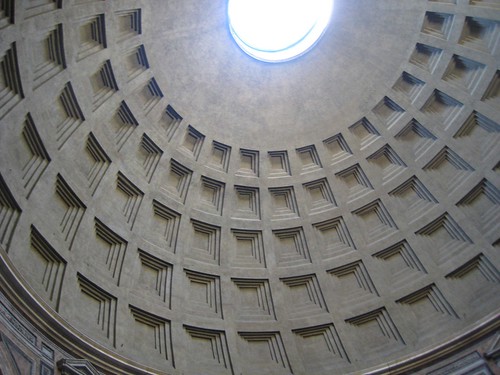 The dome of the Pantheon, my favourite part (of course) Legend says that they built it supported by an enormous heap of earth salted with gold coins. Then when the dome was complete they invited the citizens of Rome to come and cart away the dirt and keep whatever they found in it. Clever Romans.
The dome of the Pantheon, my favourite part (of course) Legend says that they built it supported by an enormous heap of earth salted with gold coins. Then when the dome was complete they invited the citizens of Rome to come and cart away the dirt and keep whatever they found in it. Clever Romans.
I could go on and on. I haven’t even mentioned the Vatican at all, and that's a whole other country. And there was the Piazza Navona (And accompanying navigational nightmare on the evening of the drinks with hashers. Let’s just say that approaching the Piazza Navona from the east looks and feels remarkably similar to approaching the Piazza Navona from the west, and leave it at that.) And there were free aperitivi at the Campo de’ Fiori, and there was that stumbled-upon intersection where the buildings on each of the 4 corners were adorned with fountains, and there was running in the park at the Villa Borghese and lots and lots and lots of walking. And of course there was more gelato (new flavours: bacio, pinioli, amarena)
But now it’s time to say arrivederci Roma and hop the train for Cassino, and another Canadian War Cemetery, and another Great-uncle lost too soon. Stay tuned for that, and Naples, and Pompeii, and the big hop to Greece for the most unprepared-for marathon of my life.
* I found out too late that Rick Steves has a big selection of free audioguides for major sights in Italy, that can be downloaded for free from iTunes. Damn!
Posted by
Pam
at
1:00 AM
|
4 Commented
![]()
Labels: Italy
Pick of Pics - Firenze
Wednesday, October 28, 2009
Posted by
Pam
at
3:50 PM
|
6 Commented
![]()
Labels: Italy, Pick of Pics
Firenze: It's not just tripe.
Monday, October 26, 2009
First of all, apologies for not posting in, oh, a week or so. What can I say? The muse was not with me, and the internet access was inconvenient, and there seemed to be better things to do. Wandering around Siena for instance, or getting to Rome. But let’s take a moment now and look back at Florence.
Florence had a lot to offer – much more than I had the time or inclination to partake in. But I did have a nice three and a half days, and I saw some of the biggies. (Actually, they call it Firenze in Italy, so that’s how I’ve been thinking about it. This helps with things like train schedules; it means you’re not standing around waiting for a train to Florence while six successive trains for Firenze speed off into the distance.)
 Firenze, taken from Piazzale Michelangelo
Firenze, taken from Piazzale Michelangelo
The hostel in Florence, Ostello Archi Rossi, provided stiff competition for the Rossio Hostel in Lisbon. (Apparently any hostel with “Ross” in the name is a good bet.) Archi Rossi had bigger rooms, and more beds per room, but even though I shared with 8 other people the room was big enough that it didn’t feel crowded at all. And there was a free computer in the room and full bathroom as well. The hostel also had all the standard stuff that separates the great from the mediocre – free wifi, laundry machines, 24-hour front desk, helpful staff. And they offer two different free walking tours, and had an extensive collection of cheap beer, wine, and snacks for sale. Like Rossio, they had free hot breakfast with about 8 or 9 choices of what to have. Unlike Rossio, or anywhere else I’ve been, the also had free supper six nights a week. Yup, two free meals a day. And the meals were decent – your choice of about 4 different pastas and about 6 different pizzas and 3 or 4 different salads. And it was prepared on site, by actual people. Brilliant.
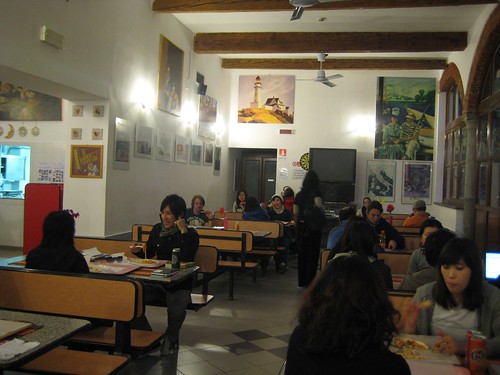 Archi Rossi Common area / cafeteria
Archi Rossi Common area / cafeteria
As for Firenze – it’s positively crammed with galleries and churches and publicly displayed sculptures, largely thanks to the Medici family. The famed Uffizi Gallery, for instance, grew out of the private collection of the Medici family which was “bequeathed to Florence in 1743 by the last of the family, Anna Maria Ludovica, on the condition that it never leave the city.” (LP). Firenze is also home to the Duomo, and, of course, the most famous hunk of white marble ever set to with a hammer and chisel (and I’m using the word “hunk” here very conscious of the double entendre). And here’s something that surprised me about David – did you know he’s about sixteen feet tall? I did not. I really thought he was closer to life size. Nope. He’s a big boy.
 David (photo thanks to Google Images, because the Accademia did not allow photos.
David (photo thanks to Google Images, because the Accademia did not allow photos.
Oh, and thank you Michelangelo.)
Firenze also has a history of producing fine leather goods, pens and stationery. There are a lot of high-end shops selling the stuff, and every two-bit kisok in every square seems to sell cheap(ish) leather wallets and books and purses. I found a great little shop on a side street (right across from Dante’s church, if you’re looking). It was exactly as homey and cluttered and personal as I’d hoped it would be. I even did a bit of Christmas shopping.
 Cluttered and perfect, with friendly English-speaking saleswoman, who loved my paper wallet (which is still going strong, thank you very much Larry).
Cluttered and perfect, with friendly English-speaking saleswoman, who loved my paper wallet (which is still going strong, thank you very much Larry).
My visit to the Uffizi was nice, though the collection only goes up to about the mid-18th century, which isn’t really my bag. I think I can safely say that after this trip is over I will never, in my life, need to see another Annunciation, or Adoration of the Magi/Shepherds, or Lamentation over the Body of Christ or (please, oh please spare me from) another Madonna and Child. The Ufizzi does have a load of nice sculpture though, and I did find “my” painting too. A very small, and probably underappreciated portrait of a monk, painted in the 1500 (!) by Pietro Perugino. It’s called “Portrait of Don Baldassare di Angelo”. (Though part of my affection for this piece may be attributed to the fact that I think it looks a lot like Patrick Stewart, for whom I have a passing fondness.)
No photo because the Uffizi doesn’t allow them, and the nice one I found on Google Images is copyrighted. Go google it yourself if you want a look. Or just imagine Patrick Stewart with a tonsure.
And, despite what the LP says, I found the size of the Uffizi quite manageable. It’s got fifty rooms (and they’re small) which is sort of titchy compared to somewhere like the Louvre or the Hermitage. And the audioguide was decent and had commentary for every room. I didn’t feel like I was racing through it, but I was still through in about two and a half hours.
I also met some good people at the hostel (well, on the free walking tours provided by the hostel). I had lunch on Friday and Saturday with walking tour people, and had an especially nice time with Narelle, who stars in my 3rd “Portrait of new friend at lunch” series. She had pizza, I had papardelle with wild boar sauce. And we shared a half bottle of Chianti.
Of course the Duomo is one of the must-see sights in Firenze and though the church itself did not take my breathe away, the dome is quite fantastic. It was designed by the famous rennaissance architect and engineer Filippo Brunelleschi, and is famous for being (I think) the first large dome ever built without supporting scaffolding underneath. So, like the Sagrada Familia in Barcelona, it was art and engineering at the same time, and thus right up my alley. I climbed up with Matthias and Heather, two single-serving friends from the hostel, so I even got a nice pic of me at the top.
Firenze also has a great collection of Tower Houses. These are, as astute GSRED readers may already have guessed, houses that are built as towers. Apparently in the Middle Ages the streets of Firenze were not the festival of high-end designer stores, trattorias, and gelato shops that they are today. In fact, wealthy families used to build their houses like mini castles, and live up above the mayhem that reigned at street level. Eventually they even built bridges linking different towers. Though there used to be hundreds of these buildings, and though only about thirty still survive, that’s enough that you can glance down almost any street in the historic centre of the city. One of my walking tours even visited the inside of one of these tower houses that’s preserved as a (free!) museum. It was fantastic, and had original 14th century frescoes on the walls all over the place, just like wallpaper.
And, to top things off, a had a good long run in Firenze – 33.3km, in about 3 hours and 18 minutes. That was my last long run before the Athens marathon, which is looming so close now it seems ridiculous. I will toe the line at 9:00am, on Sunday, November 8th, and though I know I won’t be setting any new personal records at this race, I am pretty confident I’ll finish. I’m also pretty confident it won’t be pretty.
Oh, and I've already mentioned it, but the gelato in Firenze was really top-notch. I've been keeping track of what flavours I've tried since I got to Italy, and have hit upon the brilliant scheme of having half chocolate and half something-else each time I hit a new shop. This means I'm not deprived of my chocolate fix, but I still try new things too. And these are the kind of innovative travel tips that are making things tick along so smoothly here at Go See Run Eat Drink, where we are powered by beer and gelato in approximately equal quantities.
Posted by
Pam
at
3:07 PM
|
8 Commented
![]()
Labels: accomodations, Italy
Steve's Weird Food for Italy: it was offal.
Tuesday, October 20, 2009
This time I have to blame the trusty LP Italy. Turn your hymnals to page 487 and repeat after me:
"When Florentines fancy a fast munch on the move rather than a slow Full Monty lunch, they flit by a trippaio - a cart on wheels or mobile stand - for a juicy tripe burger. Think cow's stomach chopped up, boiled, sliced, bung in a bun and doused in hot chili sauce. Yum!"
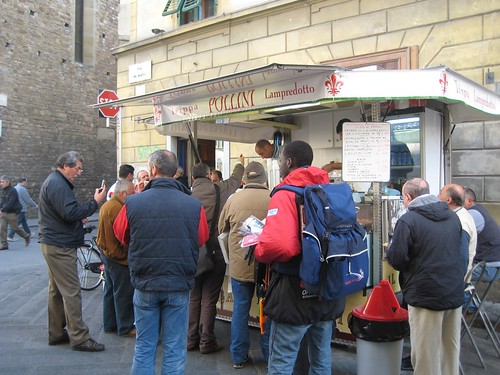 LP's pick for a traditional trippaio - it's a popular place at lunch time.
LP's pick for a traditional trippaio - it's a popular place at lunch time.I'd had a nice look at the David in the morning, and was vaguely in the neighbourhood, so off I went and found the place with no trouble at all. Trippa was clearly displayed on the menu, so there was no getting around it. Luckily, also prominent on the hand-written menu board was bicchiere di vino, at a mere €0.80. Phew! I screwed up my courage and ordered from the old guy behind the counter, who turned out to be very friendly.
 Friendly man!
Friendly man!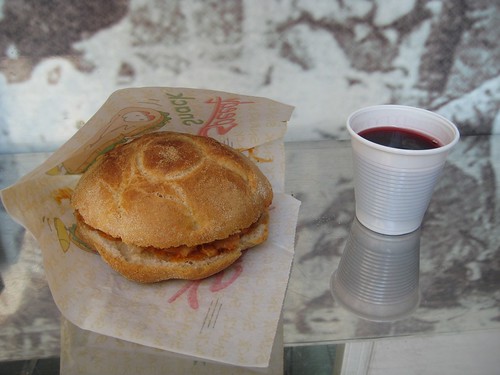 Innocent enough...
Innocent enough...And you know what? It was innocent. Not bad at all, in fact. The texture was soft and not at all stomach-y. The flavour was mild and juicy and a bit tomato-y and perfectly fine. I munched it down quite happily (and with immense relief that this was not another pig ear episode).
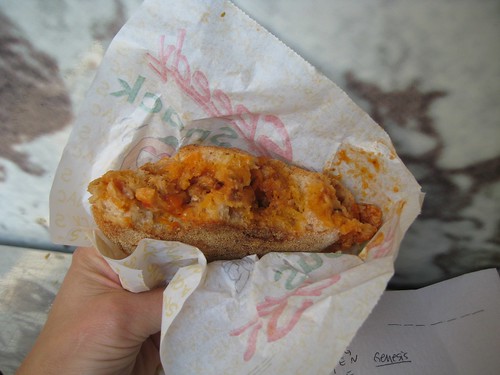 Halfway through, and doing fine.
Halfway through, and doing fine.
Posted by
Pam
at
7:20 AM
|
5 Commented
![]()
Labels: Italy, Steve's Weird Food
"La Traviata" Lite
Sunday, October 18, 2009
I wanted to see opera in Italy, and I did. But it really didn’t end up being what I was expecting.
There was a brochure at my hostel, and it seemed perfect. An opera? In Venice? How could I go wrong? So off I went to get a ticket, which turned out to be a somewhat mystifying process. I found the venue, and that was when I started to have my doubts. It was a bit Fringe-y, and there wasn’t exactly a Box Office or anything. Luckily, I ran into two women speaking French who were also trying to buy tickets, so I latched on to them. Even more luckily it turned out that one of the women didn’t just speak French, she also spoke English, and German, and (most important) ITALIAN. It’s remarkable how many people over here speak two or three or four languages. Even, or perhaps especially, people in presumably low-paying service jobs can switch between Italian, English, French and German. Really impressive. So the friendly quadrilingual woman consulted with someone behind a hidden door, who directed us to a café down the street where the proprietress behind the counter was selling opera tickets along with espresso and panini. It was weird, and like I said – Fringe-y, if the Fringe charged €30.00 for a ticket. (I know that's cheap for opera, that should have been another clue, I guess.)
 My “opera house” was just through this archway, on the right.
My “opera house” was just through this archway, on the right.
On the night of the performance I showed up and was directed into a lovely room, but it really really wasn’t an opera house. I’d been to the Fenice opera house for a tour that afternoon, and I’ve got a bit of experience in the performing arts, so you can trust me when I say this room was not a purpose-built performance venue. It was a lovely room, there’s no question of that, but it was not a theatre. It appeared we were in for something more in the way of a staged reading or "chamber opera" (if there is such a thing) rather than a fully-realized production. Still, I settled in to my folding chair and decided I was going to enjoy it anyways.
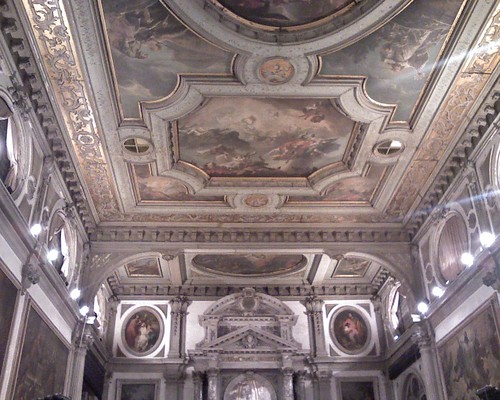 I told you it was a nice room.
I told you it was a nice room.
It was “La Traviata”, which Rob Hamilton declared would be a “prefect beginner opera”. (I called to consult him while I was waiting with the bewildered French women, trying to buy my ticket. It was great talking to you Rob, and I loved the long pause after I said, “Rob, it’s Pam. I’m in Venice.” and before you started laughing.) The orchestra was two violins, a cello and a grand piano, the set was a riser and some chairs, the lights were parcans on sticks at a truly awful angle (front light only, of course), and there were 7 in the cast. But it was Verdi, and it was Venice, and you know, I kind of liked it. It didn’t have all the pomp and ceremony of a performance in a grand opera house, but you could tell the singers were giving it all they had. It was obviously a small, underfunded group of enthusiasts. I suspect they were professional, but barely; they didn’t even have programs. (It sort of felt like Mickey Rooney and Judy Garland might show up at any moment and say “My Dad’s got a 17th century ballroom! Let’s put on a show!”) (Also their scene changes were truly awful, and that’s something that doesn’t take money to fix, you just have to actually care about what you’re doing and think about it for five minutes beforehand.) (And I did find a website later on. There's a tiny bit more information here.)
So I sat and listened and tried not to fixate on the fact that the riser boomed every time someone took a step, or that I could only see people from the waist up. And then, not long into the performance, the leading man broke out into a very familiar tune and it was kind of magic and I was in Venice and I was listening to opera and it was all fine. (It was that bit from the first act that goes Da-da-daaa, da-da-DA da-da-DA da-da-DAAA, da-da-DA dadidadiDA dadidadiDAAAA. You know the one I mean.) And so it went. The whole performance ended up feeling a bit long but not as long as I expected, and I zoned out some of the time (who doesn't in an opera?), but all in all it was a good experience.
Posted by
Pam
at
3:00 PM
|
3 Commented
![]()
Labels: Italy
Pick of Pics - Venice
Saturday, October 17, 2009
Posted by
Pam
at
3:07 PM
|
4 Commented
![]()
Labels: Italy, Pick of Pics
Venice. It's really like that.
Friday, October 16, 2009
You know that picture of Venice you have in your head? Yeah, me too. Well, I am happy to report that Venice is exactly like that. Perhaps this was naive, but I had no idea it was going to be so… VENICE. All of it. There doesn’t seem to be a square inch of Venice that isn’t perfectly exactly like it should be.
I walked out of the train station on Friday and the first thing I saw was the Grand Canal, and I was simply blown away. It was right there and it hit me like I haven’t been hit in a while. I admit that I’ve been getting a bit jaded on this trip. “Oh, another fabulous European city. Ho-hum. What? A roman ruin? Uh huh, what else have you got? A 13th century cathedral? A world class museum crammed with masterpieces? Whatever….” Please don’t hate me for saying that. I know a lot of you are reading this in Canada where the temperature is dropping, and Thanksgiving is over, and the days are getting shorter. You’re probably wishing you could trade places with me, or at least reach through the computer and give me a good slap. I know that. And if I could trade places with some of you for a weekend, I’d honestly do it. But not in Venice.
On that first day I dropped my stuff at the hostel (and updated the “Last Known Location” and map on the blog, of course), and then headed out to do the LP walking tour of Venice. As the Good Book says: “When you arrive at the train station, don’t follow the crowd down the main drag to Rialto and on to San Marco. Make a tour of it and take the long road!” And so I did, and I was glad of it. I wandered along the streets and (remarkably) only got lost once, and just drank it in. I must have been walking for at least an hour before I realized one of the things that made it feel so different (other than the canals, of course, which aren’t exactly new for me… St. Petersburg, Copenhagen, Amsterdam, Utrecht, Bruges, Ghent). It’s that there are NO CARS. None at all. I think I realized this for the first time when I saw these:
If it’s not on a boat, or on a cart, or on foot, it doesn’t move in Venice. (Well, actually I saw a little motorized luggage cart thingy outside the train station, but that was it. And it may have been electric.) This means that the place is soooo quiet. And it’s completely free of exhaust fumes and road rage and traffic lights and gas stations and parking lots and overpasses and roundabouts and cars on the sidewalk (Portugal, I’m talking to you about that last one). And you don’t have to look both ways before you cross the street, because you’re NEVER crossing the street. It’s all sidewalk. It’s bloody magic, and very human.
Well I say it’s all sidewalk, but of course there are lots and lots and lots of canals. And a really unbelievable number of gondolas, along with loads of other small boats, and water taxis, and police boats, and ambulance boats, and UPS boats, and cargo boats, and garbage boats, and private boats, and the vaporettos (They’re the bus boats, and the map that shows the routes looks just like a metro map, but it’s for boats! It’s so cute!). But it’s the gondolas you notice. The guys really do wear the striped shirts and the straw hats, and there are about 9 squillion of them. Really, I can’t imagine that the tourist traffic can sustain that many gondolas (especially at about €80 for 40 minutes, according to the LP). Most of them seem to be sitting idle, or parked side by side by side, with gondoliers hanging out in clumps nearby (And how cool would that be to put on your tax return? Occupation: gondolier. Seriously.)
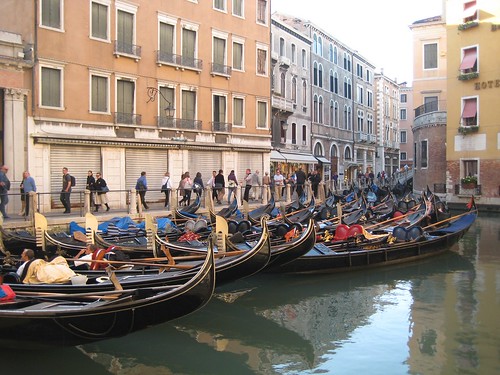 Well, I guess there kind of are parking lots…
Well, I guess there kind of are parking lots…
On my first full day in Venice I met Jocelyn – a single-serving friend from my room at the hostel - and we ended up hanging around together all day. It was just the kind of chance meeting I’d been hoping to have more of on this trip, and it was great. We took the vaporetto to San Marco, had a quick look around the Basilica, and then went for a coffee so Jocelyn could look at my LP (She was travelling without a guide book! God, that’s like an acrobat working without a net; I gives me the willies!) She only had a day in town, and a limited budget, and a love of all things to do with boats, so she decided to check out the naval museum and didn’t object to me tagging along. The museum was not bad, and really big. Big enough that we zoomed through it near the end because we both really needed some lunch.
 Jocelyn, at lunch (Hope you don't mind making a guest appearance...)
Jocelyn, at lunch (Hope you don't mind making a guest appearance...)
And then on a bit of a whim, we decided to get a vaporetto over to the island of Murano, where they make all the Venetian glass. And they make a lot of glass. Pendants, earrings, vases, chandeliers, rings, masks, plates, glasses, crying clown statues, bottle stoppers, barrettes, hat pins, beads, necklaces, bracelets, complete sets of Simpsons characters… there must be a hidden army of glass-blowers and melters and twisters and shapers on that little island. There is a glass shop approximately every thirty feet in Venice, and it's the same on Murano. Like with the gondoliers, my first look at a glass shop was exciting. Then I though, “Oh, another glass shop!” and then, “Seriously, more glass shops?” until finally I was (wait for it)… simply glazed over (Sorry about that, but it had to be said. Also, it was actually Jocelyn’s line.)
We did have a look into a few of the workshops that supply the glass shops, and we got to see some of the maestros blowing glass. It was fascinating and impressive, but hard to photograph them in action.
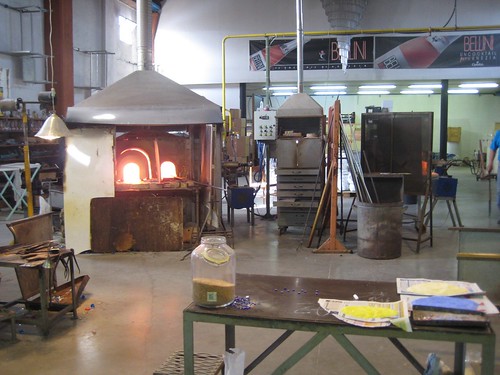 Here’s a look at the first workshop we went to, where we were accosted/befriended by the slick Italian-suited salesman who chatted us up even though it was clear we were not going to order one of his €10,000 custom-made black glass chandeliers. I wanted to, but it would have been a nightmare to pack.
Here’s a look at the first workshop we went to, where we were accosted/befriended by the slick Italian-suited salesman who chatted us up even though it was clear we were not going to order one of his €10,000 custom-made black glass chandeliers. I wanted to, but it would have been a nightmare to pack.
I went to Piazza San Marco too, of course. In fact, it’s hard not to go to San Marco because even though Venice is an absolute maze of tiny winding streets and canals and bridges, there are special signs all over that point the way to San Marco and Rialto if you’re heading even vaguely in that direction. And coming away from San Marco there are signs that point to Ferrovia (the train station and, happily, right near my hostel) and Piazzelle Roma (the bus station). It’s actually pretty hard to get really lost in Venice. And even if you do, it’s so small that it doesn’t take long to get back on course.
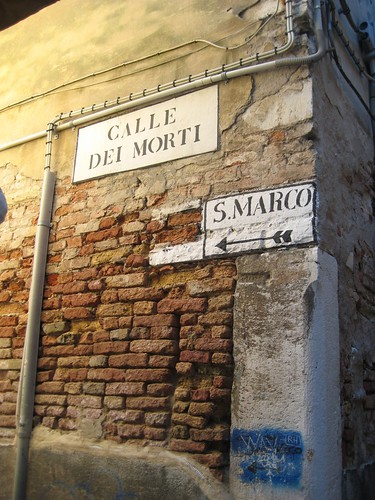 Most of them are even fancier than this, and some are just graffiti.
Most of them are even fancier than this, and some are just graffiti.
So… San Marco. It was big and fairly crowded but not as crowded as I expected, probably because it’s mid-October and the temperatures were quite chilly the whole time I was in Venice. There are some famously posh cafés on the square, with terraces set up and live bands playing (and I’m not just talking about the Wandering Accordion Division here, I mean risers set up with jazz trios and string quartets and grand pianos and such). The LP warned that prices in San Marco are heart-stoppingly expensive, but even with the warning I was shocked when I checked out the menu at Café Quadri. An espresso – a single shot of espresso that costs about €0.90 at an average neighbourhood bar – was €5.70. No, that is not a typo. Five euros and seventy cents. God, for that price it should come with an espresso machine for you to take home with you. And a pint of beer? €11.50. Needless to say, I did not partake, no matter how many grand pianos there were.
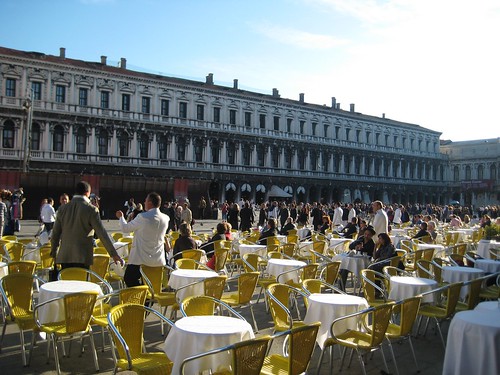 The terrace of a café on San Marco
The terrace of a café on San Marco
The water is everywhere in Venice, and just like on tv there are houses and hotels and other buildings with doors that open right onto canals - no sidewalks between the front of the houses and the water. I’m guessing that the other side of the buildings open onto a street, but you don’t see that from the water side. And it’s all really run down, or crumbled, or stained. The whole city looks like if you gave it a good shove it might just crumble. It certainly adds to the charm of the place, though, and makes it feel a bit less Disney-like, but I do wonder why one or two people haven’t had the urge to break out a can of paint in the last 200 years.
Yep, you really can't get away from the water. There are times when it rises and comes right over the sides of the Grand Canal, or into San Marco. At major tourist spots like that they set up risers called passarelle to keep people dry. Then when the water goes down teams of men come and dismantle the passarelle and stack them up in the square.
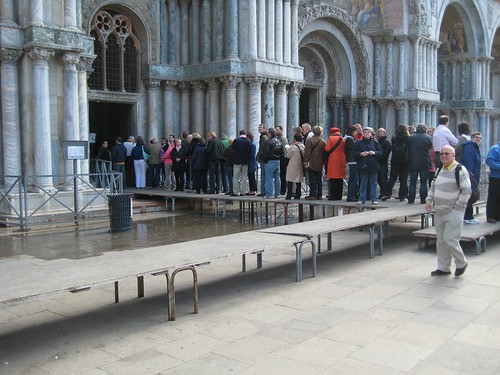 The line to get into the Basilica San Marco, standing on passarelle
The line to get into the Basilica San Marco, standing on passarelle
At other places, though, the water just does what it wants and people deal with it. I don’t know what they do in houses and businesses. The LP says that the rising of the water and the sinking of the city mean that the water level has gone up somewhere between 23 and 60 cm in the last 100 years, so I think that a lot of the lower floors of those big places along the grand canal are left vacant these days. (Though I’m dredging that up from some half-remembered Rick Steves TV show that I saw about a year ago. But really, I can’t imagine how it works in those places. Even if you live on an upper floor, if you access the place from the canal side you must have to park a sturdy pair of rubber boots at the door at all times just to make your way through the front parlour and up the stairs.)
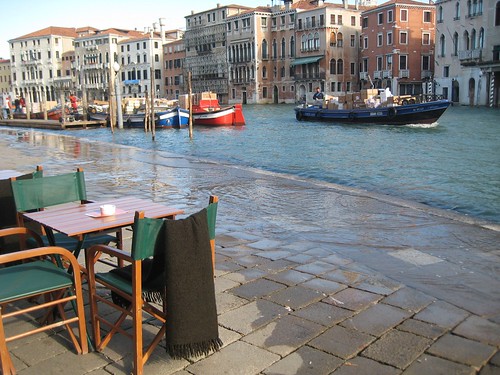 Bring those rubber boots with you to lunch, too.
Bring those rubber boots with you to lunch, too.
Mostly though, it was great just to wander the streets in Venice. I took a lot of photos that are all over at Flickr, though eventually I stopped taking pictures because everywhere you turned was worthy of a photo. Venice is… hard to describe. Even with all the tourists (and there are lots, even in October) it’s not hard to wander down a side street and be all alone in a three-foot wide lane, or staring down a narrow canal at someone’s washing hanging on a line (they must have industrial strength clothespins). It’s the first place I’ve been so far that felt really, really different. Different, and charming and fantastic. If you’ve been there, you’ll know what I mean. If you haven’t, well, I’m sorry.
Posted by
Pam
at
1:55 PM
|
7 Commented
![]()
Labels: Italy
Portugal at Random
Tuesday, October 13, 2009
You know how this works by now: stuff about Portugal, lack of interest in or time for composing something coherent, read it anyway.
- Now you know the secret of the Solar do Vihno do Porto, so I’ll let you in on another cheapie alcohol experience in Lisbon – the VinoPortugal. This is a free wine-tasting bar at Plaça Commercial in Lisbon. It’s in a lot of guidebooks so it’s not exactly a secret, which is why I was surprised that it was completely empty when I went in. Here’s the deal: they feature 20 wines from each of three different regions of Portugal, rotating through the regions periodically, because there are a lot of distinct wine-producing areas in Portugal. You go in, tell them you want to do a tasting, and they let you pick two wines and give you a form to fill out about your opinions on everything from the design of the label to the taste to how much you’d pay for the bottle. Then they pour you a tasting size sample of your two wines, and you go off to sit and taste and make notes. (“Woody undertones with distinct notes of red fruit, pig ears and wet umbrella”… that kind of thing.). And then you hand in your notes and you get to pick two more wines for the same treatment. No catch, other than you’re limited to four tastes (Per day? Per week? I don’t know, but it would be fun to find out.)
- Tricky restaurants! When you sit down at the table the waiter brings over a tasty assortment of things for you to munch on while you contemplate the menu and wait for your order. Sometimes it’s just a basket of bread and butter, but at one place Freddie and I went to it was bread, butter, tuna paste, sardine paste, olives, and a lovely round of soft local sheep’s cheese. Everything you touch goes on the bill, even if you only have a nibble. It’s not hugely expensive – bread or olives is usually under a euro, but the cheese is often €3-4. (And it’s not just Portugal. I’m writing this from Italy, and can report that a restaurant in Padua had the audacity to charge €1.50 for a package of six dry, factory-made breadsticks that were only slightly thicker than uncooked linguini and about as tasty.)
- The LP promised, and Portugal delivered. Those folks really like their pastries, as evidenced by the presence of a pastelaria approximately every 50 feet on every street in Portugal. As I mentioned earlier, the specialty of the place is the pastel de nata, a flaky pastry tart filled with custard. But these pastelaria have loads of other stuff. It was all I could do not to walk into every one I passed and try something new. Thankfully, I was uncharacteristically abstemious.
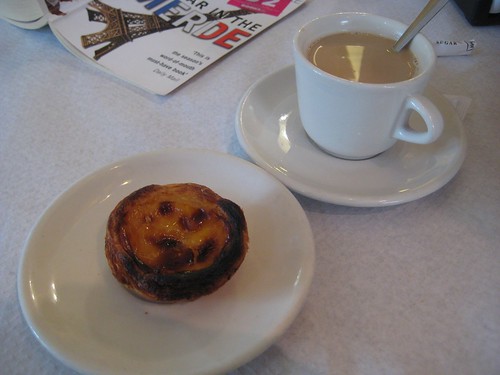 Pastel de nata and coffee. I should have had two... they’re small.
Pastel de nata and coffee. I should have had two... they’re small.
- When I was riding around with Freddie I found out about a clever system they have in Portugal for getting people to keep their speed down when driving. There are speed detectors in places that are connected to traffic lights. As long as your speed is below the limit, the light stays green. If you’re over the limit, the light turns red, forcing you not just to slow down, but stop completely. Freakin’ brilliant.
- The Hostel Report: I stayed at Rossio Hostel in Lisbon (recommended by my new best friend in Madrid, Christine) and turned out to be, by a significant margin, the best hostel I’ve stayed in so far. In fact, it was voted best small hostel in the world (2008) by the people who frequent Hostelworld.com, and I can see why. Here’s just a sampling of its charms, available for just €18 per night:
- Perfect location, just off Rossio Square
- Clean rooms with only 4 beds each
- Large, free lockers in the room, with locks provided
- Free towel and bed linen
- Clean, bright, cheery, well-designed bathrooms
- Sunny, pleasant common room
- Separate tv room with wide screen tv, and library of DVDs
- Lovely kitchen
- No lock-out
- Free wifi and free computer terminals
- Free hot breakfast – scrambled eggs and toast, or crepes, with coffee and tea, juice, and cereal. I’m not kidding, you came down in the morning and a happy woman asked what you wanted for breakfast, cooked it to order, and brought it to you at the dining table. It was like a dream.
- Laundry service: For €5 they would do a load of laundry for you – washed, dried and folded - and return it to you in a tidy little tote which would be waiting on your bunk by late afternoon.
- A cooler of water, soft drinks and beer, all available for €1 per can
- Really friendly and helpful reception staff. They could tell you how to get to any of the tourist spots, which bus to get to the airport, and what was playing for movie night.
- A handful of umbrellas by the door, just in case
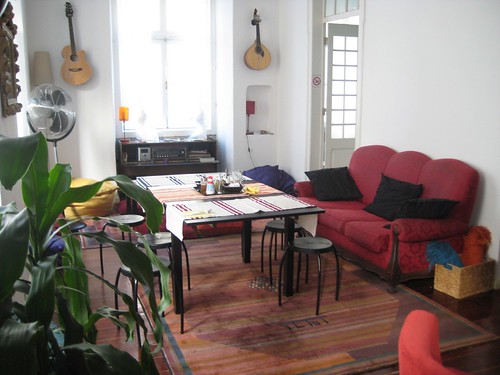 Rossi Common Room, set up for serving breakfast
Rossi Common Room, set up for serving breakfast

Posted by
Pam
at
1:43 PM
|
13 Commented
![]()
Labels: accomodations, Portugal
Obrigada, Lisboa
Sunday, October 11, 2009
 Tram 28
Tram 28
I was enjoying the ride, so I decided I’d just stay on and see the whole route, reasoning that it must just end up back where it started from at some point. Heh. It turns out that reasoning was errado. In fact, Tram 28 delivers you to Estrela, quite a long hop from Rossio and then the route just ends. If you’re a (clueless) tourist, you then have to walk across the square and get bus #706, and ride all the way back. Consider yourself warned.
As I mentioned, I’ve taken quite a liking to a nice glass of port, and Freddie was kind enough to alert me to the location of the Solar do Vihno do Porto, which turned out to be just 275 steps from my hostel (and in Lisbon, steps mean stairs not paces. It was perhaps a ten minute walk, but in that ten minutes I climbed 275 steps. Lisbon is an exceptionally vertical city.) Anyways, the Solar do Vihno do Porto is lovely bar subsidized Portuguese port producers, where you can enjoy a glass of one of about 973 different kinds of port, ranging in price from €1.10 to about €16.00 per glass. Most of the stuff mere mortals drink clocks in around €2-6 per glass. I went two nights in a row, and tried two different ports each night. My favourite was the Ramos Pinto 10 year old tawny which was very very nice indeed. And the bar itself is just a lovely place to sit. It was quite warm and sticky while I was in Lisbon, and the SdVdP was enthusiastically air-conditioned, and open until midnight. And the inside is just like you’d imagine – dim lighting, red armchairs, big wooden beams, and stone walls. And the waiters wear aprons and bring your glass of port on a tray, along with the bottle, so you can check the label before you sample. I felt a bit like I should be wearing a smoking jacket and sucking on a pipe or something. Just great. You should go to the Solar do Vihno do Porto, probably right now. Go ahead, I’ll wait.
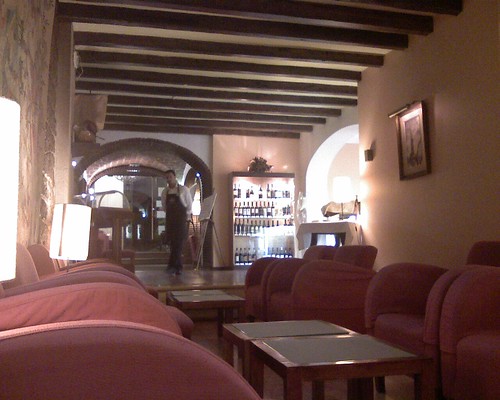
A fuzzy look at the Solar do Vihno do Porto 
As I mentioned above, the castle is in the old Moorish quarter called Alfama. It’s got loads of little windy streets, and my guide book’s number one recommendation for things to do in Lisbon was to wander the tiny alleys and back streets of the area, getting lost and seeing what was to be seen. Given my oft-mentioned proclivity for wandering around lost, you’d think this would be right up my alley (It was not. Even though I knew it was going to happen, I was still annoyed when I got lost on my way back to the hostel.) The castle São Jorge was nice though – mostly deserted inside, but with excellent ramparts and stunning views of the city.
 The view of Lisbon from the castle
The view of Lisbon from the castle
On Wednesday I took a trip out to Belem, where there’s a nice monastery and a famous bakery that purports to be the origin of Portugal’s signature dessert, the pastel de nata. It’s a custard tart in flaky pastry, and goes nicely with a cup of coffee.
My favourite sight out at Belem, though, was the Berardo Collection – it’s a gallery of modern art pieces that were owned by José Manuel Rodrigues Berardo , and is now housed in part of the enormous cultural centre in Belem. (And admission is free, so there’s no excuse to skip it.) I was interested in seeing the permanent collection, which includes Hockney and Warhol and such, but the entire collection was being re-worked so there were only temporary exhibits open. One was a quite diverting (often very oblique) look at time and calendars such. There were a few really interesting things there, and it was the kind of discovery that’s especially nice because it was unexpected, and free.
There was also a big exhibit on the life and career of Amalia, a famous Portuguese fado singer who died ten years ago. I was not hugely interested in the exhibit, but there was one room that I just loved. It was dark, with black walls and there was a sound track of fado playing, and hanging in the room were three enormous sculptures that were rotating slowly. They looked a bit like giant paisley chandeliers: one red, one black and one yellow. They were really lovely, and caught the light beautifully. And then I looked closer and realized that they were constructed entirely from translucent plastic disposable cutlery – knives and forks and spoons – that had been twisted and curled and glued onto a frame of welded steel rods. And that just made it even more fantastic. I took quite a few pictures but they didn’t turn out well because the pieces were always in motion.
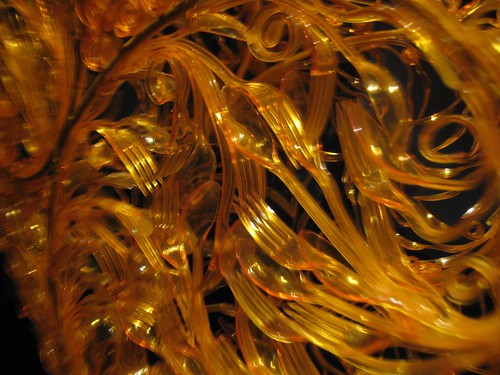 Here’s a close-up that I prefer to think of as “arty” rather than “out of focus”. (More “arty” shots over at Flickr)
Here’s a close-up that I prefer to think of as “arty” rather than “out of focus”. (More “arty” shots over at Flickr)
I did make it out to the Museu des Azulejos – the Tile Museum (ceramic tiles, that is, which are absolutely EVERYWERE in Portugal. Entire buildings are covered with them). It came highly recommended, but I have to say I found the whole thing a bit of a snooze. I mean the displays were pretty, and the building was nice, but on reflection it may have been a bit ambitious to expect that a museum devoted soley to the history and display of ceramic tiles in Portugal would be hugely riveting.
 Yup, there’s some tiles. (“Oh look over there! More tiles. I wonder what could be in the next room?…”)
Yup, there’s some tiles. (“Oh look over there! More tiles. I wonder what could be in the next room?…”)
And once again, the hash came through for me. After having a nice run with the Lisbon group on the previous Saturday, I met up with one of their number, Dave, and his Portuguese friend Antonio. We went for a nice dinner and had a great night chatting and drinking wine and eating. Then Dave and Antonio took me to a positively fantastic bar whose decor was not to be believed. It was a warren of cozy rooms, one after the other, and each room was absolutely crammed with odd collectibles of every possible type – dolls, toy soldiers, model airplanes, hats, ceramic figures, military medals, cigarette cards…. on and on and on. You could stare at a single wall for hours and still glance back and see something new. We played pool (badly) among the china frogs and action figures and drank beer (and port) and had such fun that they actually had to throw us out when the place closed at 2am. It was a great last night in Portugal.
And you’re right, I did not tell you the name of the bar. I have to have some secrets. If you want to go you’ll have to head to Lisbon and look up Dave. But I can assure you, it would be worth the effort, as is the case for the whole country, in fact.
Posted by
Pam
at
1:44 PM
|
1
Commented
![]()
R&R in Portugal
Wednesday, October 7, 2009
It was a perfectly excellent few days. I arrived in Lisbon on the overnight train from Madrid, and was met at the station by my old teacher/mentor now colleague and friend, Freddie. (Never mind that poor Freddie was making his second early morning trip in to Lisbon in as many days since I’d mistakenly told him I was arriving Thursday morning, when of course I was leaving on Thursday and arriving on Friday… but then again I can barely remember what month it is these days. It’s still August, right?*). Despite the confusion of the previous morning, Freddie was in his usual good spirits and whisked me off to his spare room in the small town of Sesimbra. And then, because there was exceedingly noisy work being done on his back patio (involving a jackhammer), we immediately buggered off for the day.
We drove south to Setúbal and wandered through a great market there where I picked up some fruit, and was scolded by a lady for squeezing the pears, and Freddie educated me in the 87,392,493 different types of fish and seafood for sale. They do like their fish here.
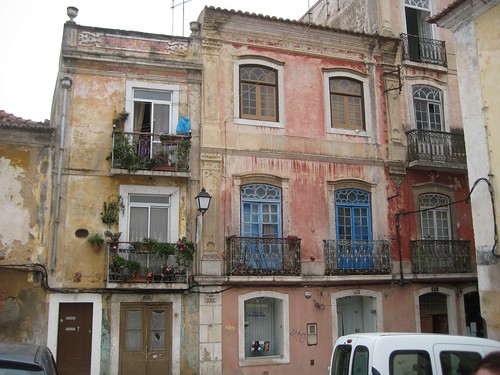 And picturesque neglected buildings in Setúbal.
And picturesque neglected buildings in Setúbal.
After killing some time in Setúbal, we got the ferry to Troia and had a nice long drive, aiming at a small roadside restaurant that Freddie knew (one of countless restaurants Freddie knows). Tragically, the place was closed down, taking with it what was apparently the best Porco Alentejo with it (pork with clams). Instead we opted for a place just up the road and had a lovely long lunch, accompanied by lashings of tinto de casa (made on the premises). I had chocos fritos – fried cuttlefish, which were tasty but I think should easily qualify as Steve’s Weird Food for Portugal. Well, just look at them:
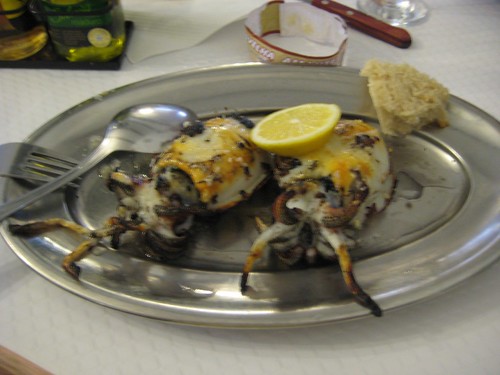 Chocos Fritos, somewhat out of focus. But yes, they did look like baby aliens. (Also, I have to add that it is just downright WRONG that these are called “chocos fritos” which should clearly be something involving chocolate and heat combined in a delicious and satisfying way, and not anything with freakin’ TENTACLES, however tasty those tentacles might be. I mean, REALLY.)
Chocos Fritos, somewhat out of focus. But yes, they did look like baby aliens. (Also, I have to add that it is just downright WRONG that these are called “chocos fritos” which should clearly be something involving chocolate and heat combined in a delicious and satisfying way, and not anything with freakin’ TENTACLES, however tasty those tentacles might be. I mean, REALLY.)
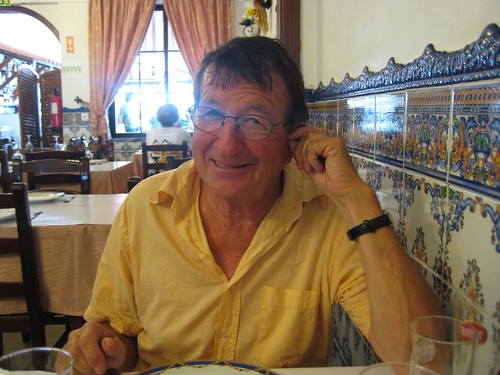 And my host. Lookin’ good, Freddie!
And my host. Lookin’ good, Freddie!
After lunch, we went to a beautiful stretch of white sand beach for a bit of a break. I had a book with me but after laying down a towel and stretching out on the sand, I was unconscious in moments. Naturally Freddie had planned the whole business, reasoning that after a night on the overnight train and a big lunch I’d need a siesta, but that jackhammering would not be as appropriate an accompaniment to that as crashing waves. He was right of course, an attentive host indeed.
And then there was the leisurely drive back to Sesimbra, and the relaxed pre-dinner conversation, and the aperitif before heading for another little place in the next town for a dinner of more beautiful seafood. This time it was gigantic shrimp, split in half and lightly grilled, ordered by the half-kilo. And a bottle of tinto de casa, naturally
On Saturday I spent 3 hours making my way to the start of a run with the Lisbon Hash House Harriers. I left the house just before 11:00am, and travelled by bus, ferry, train and car. (It was easily the longest I’ve ever traveled for a hash, but definitely worth it, despite the fact the the return trip was even longer - 3-1/2 hours - due to the unfortunate timing of ferry arrival and bus departure.) The run started at about 2:30 and was 12.8km of exhausting, hilly, hot, dusty running through trails and scrub and infrequent shady glades, and it was just great. The Lisbon Hash is a big group – well-organized and very family-friendly. I’ve never seen that many kids at a hash before. And we had two namings and a re-naming. And I met some good people, including a woman recently posted to the Canadian embassy, who may be able to help me with a bit of a puzzle to do with visas.
Sunday was a lazy day – Freddie’s spare room is equipped with light blocking shutters and the town is small and quiet, so I slept until almost 10am and lounged about all morning, with only a brief foray to the market. Lunch was at home on the balcony, where we sat in the sun and watched the sea mist roll in and obscure the entire town.
And of course we discussed the plans for dinner. In fact, the whole visit felt a bit like a Food Network special, which is positively brilliant. I’ve now had cuttlefish, shrimp, monkfish, octopus, baby squid, clams and swordfish. And I’ve sampled a great variety of local wine, and learned a lot about it, and I’ve even had some instruction in port (which I requested since it is, after all, Portugal). It turns out I like port very much, which is a good thing to know. I love that an appropriately significant amount of our time was spent in contemplating where and what we might next eat and drink. And I love that one of the things I heard most was, “Red, white or rosé?”. Either that, or, “How’s your glass?” (As if to imply that the glass itself might suffer some damage if the liquid level were to get dangerously low.)
Monday was Republic Day in Portugal, a national holiday. I got up and headed out for a run in the NEW SHOES that arrived, along with a bunch of other good stuff, in the care package that was waiting for me in Sesimbra (Thanks Karen, and Steve, and Lisa!). I hoped the run would be about 10km long, but I ran smack into the preparations for a 10km road race to be held along precisely the route I was planning. I thought briefly about trying to enter the race on the spot, but my enthusiasm was as limited as my Portuguese (I can say Yes, No, Thank You, Good Morning, Good Evening, One way, Return, and Dessert. Oh, and Tinto de Casa…), so I contented myself with trying a run up a gravel road at the end of the town. That ended up being about as hilly as the run up to Arthur’s Seat, so I tried my luck back down at sea level but got hemmed in my the race and had a long and humid (and yes, partially lost) walk up the hill back to Freddie’s.
Later that afternoon, after another leisurely lunch and some quality relaxation time, we went out to explore the Moorish castle at Sesimbra, which turned out to be perfectly excellent. It’s almost like a cartoon of a castle, it’s so perfect. It actually reminded me of the Fisher-Price castle that I always coveted as a kid, and it actually looked at lot like the castle my Dad made me out of cardboard, since I didn’t have the Fisher-Price Castle. (Mine was called “Happy Castle”.) I mean, just look:
It had great crenellations (which sounds a bit like a lame medieval pick-up line, “Hey baby, those are some great crenellations. Wanna come back and check out my keep? It’s got an en suite garderobe and you can see the severed heads on the tower from my arrow-slit.”), and great ramparts, and unlike every other castle I’ve been to, it was completely deserted. There were no ticket booths or barriers or turnstiles or audioguides or hordes of cruise-ship based tour groups. It was a great treat.
After that, we visited an abandoned convent on a very windy bit of clifftop, that afforded this reasonably acceptable view:
And then it was really time to think seriously about dinner, which ended up being the aforementioned swordfish, which was excellent. (Lesson from Freddie: Do not even bother ordering the swordfish if the raw meat is not slightly tinged with pink - as in the photo above. The stuff that’s all white will dry up and be horrible and disappointing.) And then there was the after-dinner port, and the last bits of sitting on the balcony chatting, and not chatting, and attempting to phone Canada, and not getting to talk to who we wanted to (Norberts, I’m talking to you.), and a general sense of well-being that I hope Freddie shared.
The next day I packed up and Freddie drove me in to Lisbon to the brilliant hostel I’m now at, and I’ve been enjoying the city. But that’s another story. This part of the story ended when I said goodbye to Freddie and turned my face to Lisbon, and you’ll have to stay tuned to see what happened next.
* At the request of ROB HAMILTON, I am attempting to cut out the ***s at the end of posts, so let me know what you think about having these slight diversions buried parenthetically in the text instead of piled up at the end. Rob’s argument is that he’s forgotten what the associated subject was by the time he gets to the end. My intention was always that the reader would scroll down to read the *** right after the text, and then scroll back up to continue, but maybe that’s asking too much. Or maybe Rob doesn’t know how to use the scroll-wheel on his mouse. Or perhaps we need to take up a collection to buy Rob a mouse with a scroll wheel. Thoughts?
Posted by
Pam
at
2:24 PM
|
8 Commented
![]()
Labels: hashing, Portugal, Steve's Weird Food

